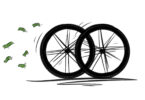Mont Ventoux

It’s hard to compile a list of the greatest climbs without including Mont Ventoux. The “Giant of Provence” at 1912 m is by far the highest climb in the Vaucluse region and dominates the surrounding landscape. Its 60 m telecommunications mast perched on the summit makes it an easy spot and is reminiscent of a spaceship on a launch pad. It’s also the ultimate goal for any cyclist trying to ascend “the Giant of Provence”.
The classic route from Bedoin doesn’t really start until the road takes a sharp left turn at St Esteve, 5.5km outside the town. It’s at this point that the road ramps up and heads through a forest for the next 10km. This is actually the steepest part of the climb at an average of 9% but Mont Ventoux is best known for its upper slopes which start just past Chalet Reynard where woodland gives way to exposed, barren slopes which are littered with limestone scree. This final 6 km section is devoid of any vegetation (a result of systematic tree felling in the 12th century for shipbuilding in the Toulon region) and takes the full impact of the Mistral winds which have been recorded as high as 200 mph and which gave the mountain its name.

But it’s not just its physical statistics that make this mountain so impressive, the history bestowed upon it through the races that have visited have given it a fearsome and mythical status within cycling folklore. This is where Tommy Simpson collapsed and died within sight of finish in 1967 and where Eddy Merckx needed oxygen after winning the stage in the 1970 Tour de France. It’s also where Armstrong “gifted” Pantani a stage win and where Eros Poli, the rider least expected to win a stage at 6’2” took a surprising win on top of the Ventoux.
Overview
Mont Ventoux (Bedoin): 1912 m
Length of ascent: 21.4 km
Meters in height: 1639 m
Ascent (average): 7.6%
Ascent (max): 12%
Strava Segment: strava.com
Strava KOM: 1:04:03 h
Strava QOM: 1:17:21 h






